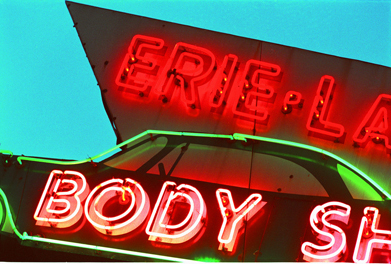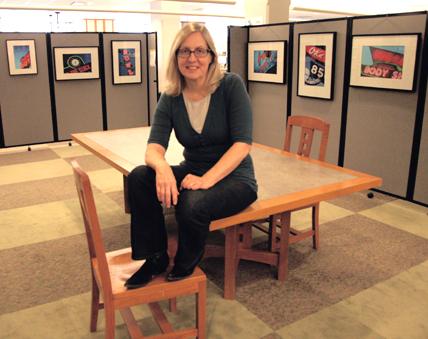Barbara Freeman is a local photographer, film director, and the latest artist to be featured in our ongoing exhibition series Local Art @ EPL. Her show – titled Road Light – is currently on display on the 2nd floor of EPL’s Main Branch and captures the mystery in local, vintage road signs with a photographic series in eye-popping color. You can catch Road Light through the end of October, and after that, you can check out more of Ms. Freeman’s photography and film work at the website for her production company Freeman Pictures, Inc. I recently spoke with Ms. Freeman via email about her artistic “Aunt Babe,” urban inspirations, and desire to preserve the past through photography.
Can you tell us a little about your background as an artist? How did you get started in art? Was there something specific in your life that sparked a need to create? What drove you to create in the beginning? What drives you now?
I have always created art as far back as I can remember. I think it is an impulse born into most people, including myself. Maybe it is somewhat herediatry. I had a beloved aunt, “Aunt Babe,” who was kind of an outsider artist. She constantly made paintings and sculptures and her home was filled to the brim with her art – every wall was covered with paintings. Making things just became part of the landscape for me, and I still get an enormous amount of pleasure out of creative work. I do it because it is so much fun!
How do you describe your art? Do you see yourself as fitting in with any specific artistic movements or styles?
I have never really been one to fit in with a movement or style since I just make what I like, but my favorite artists include Edward Hopper, Frida Kahlo, Andy Warhol, and pretty much all renaissance painters. So I guess I would have to say the styles I love and the ones that influence me combine the 14th to 17th centuries and the mid-1900’s — an odd combo, but one I think you can see in my work if you look at all my projects as a whole.
What was it about the 1940’s, 50’s, and 60’s signage that first attracted your photographic eye? Did you initially find yourself drawn to certain signs purely for visual reasons or more for, as you put it, the feelings of mystery, loneliness, and fun they seem to embody? Do you often find inspiration for your art in urban environments? What else inspires you to create?
Multiple things attracted me to these signs. First, there is something magical about the light at the end of the day when it is almost, but not quite, dark. That’s why in the film world it is called “magic hour.” I was attracted to these signs because — even though they were meant to be advertising — I find their colors and patterns to be quite beautiful and evocative at dusk. And, I am interested in signs in general. I see some of them as “messages in a bottle” — messages people send out into the world or a way  people are reaching out into the darkness without knowing if there is anyone on the receiving end. I am touched by people trying to reach out. Also, these signs seem to be from a lost time and, to me, seem to have a lot of personality in them in a way we don’t see today. I think that is another reason why they evoke feelings of mystery, loneliness, or fun.
people are reaching out into the darkness without knowing if there is anyone on the receiving end. I am touched by people trying to reach out. Also, these signs seem to be from a lost time and, to me, seem to have a lot of personality in them in a way we don’t see today. I think that is another reason why they evoke feelings of mystery, loneliness, or fun.
Yes, I do often find inspiration for my art in urban environments and also in small towns and cities. Truthfully, I am a little lost when I am sent out with a camera to shoot a gorgeous landscape, but on a walk through a small Illinois town on the Mississippi that time has somewhat passed by, I see beautiful and touching images everywhere. There is nothing more inspiring for me than a road trip — I always know I will find something beautiful. Or at least something that is beautiful to me!
In introducing “Road Light,” you wrote of your desire to find and preserve the “often unnoticed dramas” in architectural artifacts. Could you further describe this interesting idea of “unnoticed drama?” What drove you to want to preserve it? How do you feel now that many of the signs have disappeared?
I am saddened by seeing so many of these beautiful signs disappear, and I am shocked at how fast it has happened. I am often approached while shooting by people who ask, “What are you doing? Why would you want to take a picture of that?!” I think these signs/messages from another time deserve better than that and want to help preserve them. I have also noticed – now that the signs are disappearing so quickly – that many people have become very nostalgic for them. So, I am glad to have made these images.
Besides exposing you to many signs by requiring you to travel frequently throughout the Chicagoland area, how has your work as a film director influenced your photography?
Being a film director influences me to create images that tell or imply a story, and I also tend to work in series — I like to make a set of images on a theme — probably because I am so used to working with more than just one frame.
You stated you began creating your “Road Light” series in late 2001. Do you have any plans to develop the project further?
I am still shooting images for this project whenever I can. As a matter of fact, I was just in Lowell, Arkansas a week ago on a commercial project and was taken to lunch at a diner-type restaurant the locals call a “chicken shack.” It had a beautiful neon sign in front of it. So the second I finished my commercial work, I grabbed my still camera and managed to get off exactly one shot before the sign was turned off. But it was a good one!
How do you find Evanston and the Chicagoland area as a place to work and exhibit as an artist? What inspires you as an artist about the community where you live?
This is a fantastic place to work, live, and exhibit. The creative community is open and supportive. There are lots of opportunities to work and exhibit, and the general public is very interested in the arts. I think Evanston is particularly rich in the arts and its support for the arts at every level.
I am inspired by being able to see so much great art in Evanston and Chicagoland. I find my batteries are constantly being charged by the great work being done in this area.
Interview by Russell J.

